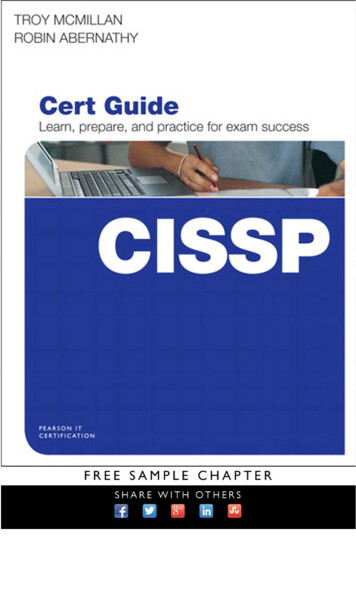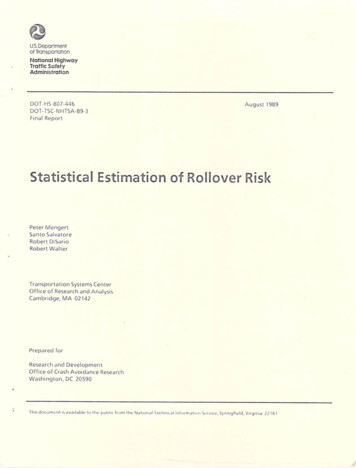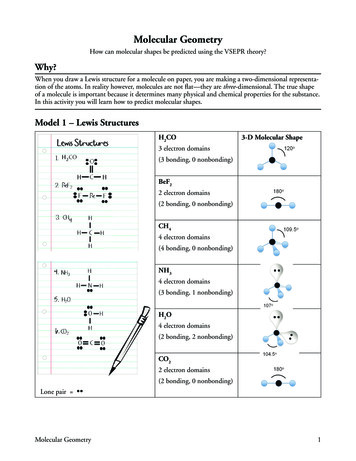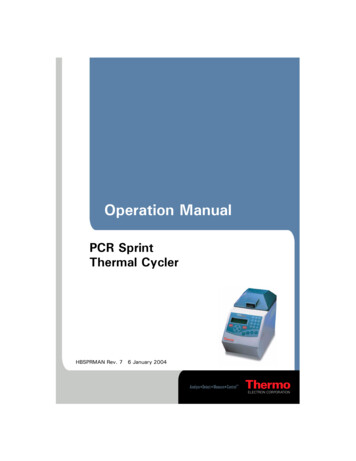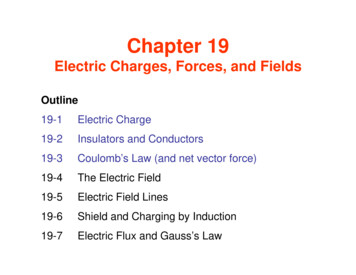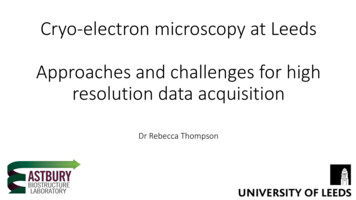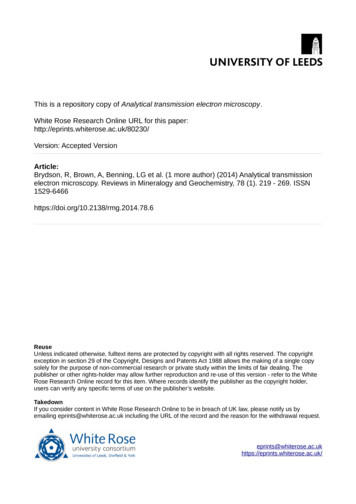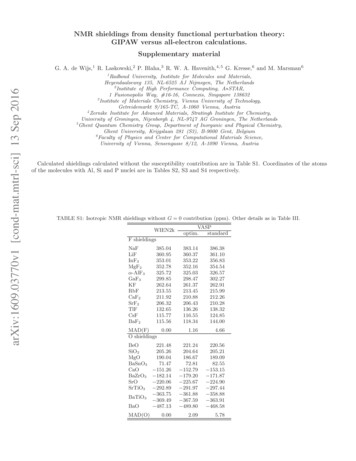
Transcription
NMR shieldings from density functional perturbation theory:GIPAW versus all-electron calculations.Supplementary materialG. A. de Wijs,1 R. Laskowski,2 P. Blaha,3 R. W. A. Havenith,4, 5 G. Kresse,6 and M. Marsman6arXiv:1609.03770v1 [cond-mat.mtrl-sci] 13 Sep 20161Radboud University, Institute for Molecules and Materials,Heyendaalseweg 135, NL-6525 AJ Nijmegen, The Netherlands2Institute of High Performance Computing, A STAR,1 Fusionopolis Way, #16-16, Connexis, Singapore 1386323Institute of Materials Chemistry, Vienna University of Technology,Getreidemarkt 9/165-TC, A-1060 Vienna, Austria4Zernike Institute for Advanced Materials, Stratingh Institute for Chemistry,University of Groningen, Nijenborgh 4, NL-9747 AG Groningen, The Netherlands5Ghent Quantum Chemistry Group, Department of Inorganic and Physical Chemistry,Ghent University, Krijgslaan 281 (S3), B-9000 Gent, Belgium6Faculty of Physics and Center for Computational Materials Science,University of Vienna, Sensengasse 8/12, A-1090 Vienna, AustriaCalculated shieldings calculated without the susceptibility contribution are in Table S1. Coordinates of the atomsof the molecules with Al, Si and P nuclei are in Tables S2, S3 and S4 respectively.TABLE S1: Isotropic NMR shieldings without G 0 contribution (ppm). Other details as in Table III.WIEN2kVASPoptim.standardF 00O shieldings1.164.66221.48205.26190.0471.47 151.26 182.14 220.06 292.89 363.75 369.49 487.13221.24204.64186.6772.81 152.79 179.20 225.67 291.97 361.88 367.59 489.80220.56205.21189.0982.55 153.15 171.87 224.90 297.44 358.88 363.91 O3BaTiO3BaOMAD(O)
2TABLE S2: Atomic positions for molecules containing Al nuclei.[AlH4 ] AlHHHHx (Å)3.4999294.4346782.5651802.5651804.434678y (Å)3.4999292.5651802.5651804.4346784.434678z (Å)3.1473702.1892694.1054612.1892694.105461[AlH4 ] 925.2890923.9942126.583967[AlH4 ] 22.8247312.8247312.505351[AlH4 ] 684.7638682.8355422.835542Al2 H6Al 1.290911.000000.000000Al 1.290911.000000.000000H.000000.000000 1.160480H.000000.000000 1.160480H 1.971661 1.430667.000000H 1.971661 1.430667.000000H 1.971661 1.430667.000000H 1.971661 1.430667.000000AlH3Al.000000.000000H.000000 1.579020H 1.367472 .789511H 1.367472 .789511.000000.000000.000000.000000
3TABLE S3: Atomic positions for molecules containing Si nuclei.x (Å)y (Å)z (Å)Si2 H6 Si.000000.000000 1.174799Si.000000.000000 1.174799H.000000 1.389598 1.691101H 1.203401 .694799 1.691101H 1.203401 .694799 1.691101H.000000 1.389598 1.691101H 1.203401.694799 1.691101H 1.203401.694799 1.691101SiH4 Si.000000.000000.000000H.861738 .861738.861738H .861738.861738.861738H .861738 .861738 .861738H.861738.861738.861738Si2 H4 Si 1.052200.000000.217920Si 1.052200.000000 .217920H 1.838784 1.244259 .026953H 1.838784 1.244259 .026953H 1.838784 1.244259.026953H 1.838784 1.244259.026953SiH2 SiHH.000000.000000.132600.000000 1.091200 .928097.000000 1.091200 .928097TABLE S4: Atomic positions for molecules containing P nuclei.P4x (Å)y (Å)z (Å)P.772319.772319.772319P .772319 .772319.772319P .772319.772319 .772319P.772319 .772319 5009H.945009 .945009 .508249H .508249 .945009.945009P2 H4P.000000 1.119312 .085740P.000000 1.119312 .085740H .191443 1.364852 1.296710H 1.409764 1.237215 .010603H.191443 1.364852 1.296710H 1.409764 1.237215 .010603H3 PO4 POOOOHHH.000000 .706579 .893018.5815291.325710 .069470 1.5931601.824050.000000.0000001.156170 .569987 .897538 1.007560 1.121920 .991408.392790.804032 1.407680 1.657030 .358900 1.418850 .371290 1.145860PF3P.000000.000000.000000F.000000 1.370150 .790302F 1.187690 .686336 .787314F 1.187690 .686336 0458
NMR shieldings from density functional perturbation theory:GIPAW versus all-electron calculations.G. A. de Wijs,1 R. Laskowski,2 P. Blaha,3 R. W. A. Havenith,4, 5 G. Kresse,6 and M. Marsman6arXiv:1609.03770v1 [cond-mat.mtrl-sci] 13 Sep 20161)Radboud University, Institute for Molecules and Materials, Heyendaalseweg 135, NL-6525 AJ Nijmegen,The Netherlands2)Institute of High Performance Computing, A STAR, 1 Fusionopolis Way, #16-16, Connexis,Singapore 1386323)Institute of Materials Chemistry, Vienna University of Technology, Getreidemarkt 9/165-TC, A-1060 Vienna,Austria4)Zernike Institute for Advanced Materials, Stratingh Institute for Chemistry, University of Groningen, Nijenborgh 4,NL-9747 AG Groningen, The Netherlands5)Ghent Quantum Chemistry Group, Department of Inorganic and Physical Chemistry, Ghent University,Krijgslaan 281 (S3), B-9000 Gent, Belgium6)Faculty of Physics and Center for Computational Materials Science, University of Vienna, Sensengasse 8/12,A-1090 Vienna, Austria(Dated: 14 September 2016)We present a benchmark of the density functional linear response calculation of NMR shieldings withinthe Gauge-Including Projector-Augmented-Wave method against all-electron Augmented-Plane-Wave localorbital and uncontracted Gaussian basis set results for NMR shieldings in molecular and solid state systems.In general, excellent agreement between the aforementioned methods is obtained. Scalar relativistic effectsare shown to be quite large for nuclei in molecules in the deshielded limit. The small component makes up asubstantial part of the relativistic corrections.I.INTRODUCTIONNuclear magnetic resonance (NMR) spectroscopypresents a powerful and sensitive probe of the structureof molecules, liquids, and solids on the atomic scale. Ingeneral, however, the retrieval of structural informationfrom measured NMR spectra is a far from trivial process, since as yet, empirical rules that map between theNMR spectrum and the structure were found to existonly for relatively simple organic molecules. To connectthe features of measured NMR spectra unambiguously tocomplex structural properties therefore remains difficult(and is often impossible) without additional input fromab initio quantum mechanical modeling.In the case of molecular systems and finite clustersof atoms, the ab initio techniques traditionally used inquantum chemistry have been successfully applied to aidin the analysis of experimental solution-state NMR spectra for quite some time now.1 In the case of solid-stateNMR, finite clusters of atoms were used to approximatethe infinite solid. Ab initio quantum mechanical calculations of NMR shieldings in truly extended systems under periodic boundary conditions were first performedby Mauri, Pfrommer, and Louie,2 using a linear responseapproach.Although Mauri et al. derived their expressions starting from an all-electron Hamiltonian, practical implementations thereof used norm-conserving pseudopotentials, which largely limited its applicability to the calculation of chemical shifts for light elements. Only withthe introduction of the Gauge-Including Projector Augmented Wave (GIPAW) method by Pickard and Mauri,3and its extension to non-norm-conserving pseudo orbitalsby Yates, Pickard, and Mauri (YPM)4 several years later,did the calculation of NMR shieldings become routinelypossible for most of the nuclei commonly studied inNMR.The GIPAW method permits to obtain accurate chemical shielding with a plane-wave basis set. As in the original projector-augmented-wave method of Blöchl,5 it recovers the shape of the all-electron Kohn-Sham orbitalsnear the nucleus through an augmentation procedure involving atom-centered functions. In addition, the GIPAW method solves the gauge problem arising from incompleteness of the atom-centered augmentation functions in a way similar as done for molecules in the GaugeIndependent Atomic Orbital (GIAO) method.6 The GIPAW formalism of YPM has been implemented in several plane-wave codes (for instance, CASTEP,7 QuantumEspresso,8 and PARATEC) and is currently widely usedin the solid-state NMR community for an extensive rangeof applications (see, e.g., Ref. 9 and references therein).Recently the calculation of NMR shieldings withinthe augmented-plane-wave local-orbital (APW lo)method was implemented in WIEN2k.10–12 In this paperwe benchmark the recent implementation (by several ofus) of the linear response calculation of NMR shieldingswithin the GIPAW formalism of YPM in the Vienna Abinitio Simulation Package (VASP)13 against all-electronAPW lo results for NMR shieldings in molecular andsolid state systems and against non-relativistic LCAOcalculations using DALTON (Ref. 14) and large uncontracted Gaussian basis sets. These benchmarks serve tofurther validate the aforementioned implementation inVASP as well as WIEN2k, and as importantly, to establish the quality of the GIPAW approach and the parameterization of the atomic scattering properties involved.The rest of this paper is organized as follows: in sec-
2tion II we reiterate the linear response expressions for theNMR shieldings in the GIPAW formalism. The particulars of the PAW data sets we use in our GIPAW NMRbenchmarks and the general setup of these calculationsare discussed in Sec. III. The results of aforementionedGIPAW benchmarks are presented in Sec. IV and compared to all-electron calculations and—partly—to experiment. Conclusions are drawn in Sec. V.With the above definition the first-order change in theorbitals is straightforwardly found to be(1)(0)THEORYThe magnetic shielding tensor σ(R) at nuclear positionR is found from the ratio of the induced magnetic fieldat the aforementioned position to an externally appliedmagnetic field B:σαβ (R) Bαind (R). BβG(ϵ) " ψj(0) ⟩⟨ψj(0) (0)where jind is the current induced by the external magneticfield B. The induced current is commonly calculatedfrom the linear response of the system to the externalmagnetic field.To first-order in the external magnetic field, jind isgiven by" # (1)(0)(0)(1)jind (r) ⟨ψi Jp (r) ψi ⟩ ⟨ψi Jp (r) ψi ⟩where (0)(0) ⟨ψi Jd (r) ψi ⟩ ,Jp (r) In the above Pc 1 to be solved for ψi .%(0)(0) ψ⟩⟨ψ representsa projection onto the viriii occtual subspace.In plane wave based implementations, Eq. (2) is mostconveniently evaluated in reciprocal space,Bind (R) B r r⟩⟨r 2c(5)are the paramagnetic and diamagnetic current operators,respectively. In Eq. (3), ψ (0) denote ground state orbitals, i.e., the solutions to (6)(1)and ψthe first-order response of the orbitals to theexternal magnetic field. The sum in Eq. (3) goes over alloccupied states.In the symmetric gauge, the perturbation of the Hamiltonian to first-order in the external magnetic field, isgiven byH (1) 1L · B.2c(11)G̸ 0where G are the reciprocal space vectors. In solid statesystems there is an additional contribution at G 0,i.e., a uniform field, that is determined by the shape ofthe sample and the macroscopic magnetic susceptibilitytensor χ. For a spherical sample this contribution is givenby:Bind (G 0) 8π χB.3 (7) (12) F (q) 2F (0) F ( q)χ lim,q 0q2 and(0) (0)ϵi ψi ⟩,4πi " G jind (G) iG·Re,cG2The magnetic susceptibility tensor may be numericallycalculated as proposed by Mauri and Louie,15(4)(0)H (0) ψi ⟩(9)and the sum is over all empty (virtual) orbitals. Commonly, the sum over empty orbitals is avoided by recasting Eq. (8) as a Sternheimer equation:# (0)(1)(0)ϵi H (0) ψi ⟩ Pc H (1) ψi ⟩,(10)(3)p r⟩⟨r r⟩⟨r p2Jd (r) ϵ ϵj(1)(1)The induced magnetic field Bind is given by the BiotSavart law,!1R rBind (R) dr,(2)jind (r) c R r 3i occ(8)where G is the Green’s functionj virII.(0) ψi ⟩ G(ϵi )H (1) ψi ⟩,(13)where Fαβ (q) (2 δαβ )Qαβ (q), α, β x, y, z are thecartesian directions, and the tensor Q(q) can be writtenas Q(q) " x,y,z"1(0)(0)(0)Re{⟨unk Aγ Gk qγ̂ (ϵnk )Aγ unk ⟩}.2Nk Ωcγnk occ(14)withAγ ûγ (p k).(0)(15)In Eq. (14), the functions unk denote the cell periodicpart of the ground state Bloch orbitals, Nk is the number of k-points chosen to sample the first Brillouin zone,
3Ω the volume of the unit cell, and the sum over n and kincludes all occupied Bloch orbitals. The Green’s function in Eq. (14) is given byGk (ϵ) " u(0) ⟩⟨u(0) nknk(0)n virϵ ϵnk.(16)In practice, we have implemented Eqs. (1)-(16) withinthe Gauge-Including Projector-Augmented-Wave (GIPAW) method of Yates, Pickard, and Mauri (YPM).4The GIPAW deals with several numerical issues thatplague the PAW method (in a uniform magnetic field):(a) it reestablishes the translational symmetry that isbroken by the PAW method (see next section),2 (b) itbalances the different rates of convergence of the paraand diamagnetic contributions to the induced current –which also affects translational symmetry – via the generalized f -sum rule,2 and (c) it solves the position operatorproblem with the help of a reciprocal space modulationvector q (cf. Eq. 13).A.GIPAWwaves, i.e.,⟨&pj φ&j ′ ⟩ δjj ′ .(19)A detailed construction recipe for the projector functionscan be found in Ref. 17. For a comprehensive introduction to the PAW method we refer the reader to the seminal paper of Blöchl (Ref. 5) and the work of Kresse andJoubert.18In a uniform magnetic field B there is an additionalcomplication as the ground state orbitals acquire an additional phase factor upon translation over a vector t, inaccordance with:i⟨r ψnt ⟩ e 2c r·t B ⟨r t ψn ⟩(20)(in the symmetric gauge). This additional phase factorcauses a very slow convergence of the linear transformation of Eq. 17 with respect to the number of projectorsp̃j . To solve this problem, Pickard and Mauri introducedthe so-called Gauge-Including PAW transformation thatincludes the aforementioned phase factor explicitly:3,4# " iie 2c r·Rj B φj ⟩ φ̃j ⟩ ⟨p̃j e 2c r·Rj B .T̄ 1 jIn the Projector-Augmented-Wave (PAW) method ofBlöchl the one-electron orbitals ψn are derived frompseudo (PS) orbitals ψ&n by means of a linear transformation5 ψn ⟩ T ψ&n ⟩withT 1 "#j φj ⟩ φ̃j ⟩ ⟨p̃j .(17)(21)Using the transformation of Eq. 21, it is straightforwardto show that with any local operator O acting on ψnthe GIPAW associates a PS operator Ō acting on the PSorbitals ψ̄n :# " Ō O p̄j ⟩ ⟨φ̄j O φ̄j ′ ⟩ ⟨φ̃j O φ̃j ′ ⟩ ⟨p̄j ′ (22)jj ′where(18)The PS orbitals ψ&n are the variational quantities of thePAW method and are expanded in plane waves. Theadditional local basis functions, φj and φ&j , are nonzero only within non-overlapping spheres centered at theatomic sites Rj , the so-called PAW spheres. In the interstitial region between the PAW spheres, therefore, thetrue one-electron orbitals ψn are identical to the PS orbitals ψ&n . Inside the spheres the PS orbitals are onlya computational tool and a bad approximation to thetrue orbitals, since not even the norm of the true orbitalis reproduced. In all practical implementations of thePAW method, the all-electron (AE) partial-waves φj arechosen to be solutions of the spherical (scalar relativistic) Schrödinger equation for a non-spinpolarized atom ata specific energy εj , and for a specific angular momentum lj . The pseudo partial waves φ&j are equivalent totheir AE counterparts outside a core radius rc and matchcontinuously onto φj inside this radius. In the PAWdata sets distributed with VASP they are constructedin accordance with a revised Rappe, Rabe, Kaxiras, andJoannopoulos (RRKJ) scheme.16,17 The projector functions p&j are constructed to be dual to the PS partiali p̄j ⟩ e 2c r·Rj B p̃j ⟩,i φ̄ ⟩ e 2c r·Rj B φ ⟩,(23)jji φ̃j ⟩ e 2c r·Rj B φ̃j ⟩.As shown by YPM, to first-order in the magnetic fieldB, the GIPAW transformation of the induced current isgiven by(1)jind (r) occ #"(1)(0)2Re{⟨ψ̄i J̄(0) (r) ψ̄i ⟩}i occ"(0)(0)(0)(0)⟨ψ̄i J̄(0) (r) ψ̄j ⟩⟨ψ̄j S̄ (1) ψ̄i ⟩j (0)(0) ⟨ψ̄i J̄(1) (r) ψ̄i ⟩(24)In the above, ψ̄ (0) are the ground state orbitals, i.e., thesolutions to(0) (0)H̄ (0) ψ̄n(0) ⟩ ϵ(0) ψ̄n ⟩.n S̄(25)This equation is the GIPAW transform of the KohnSham equations (see Eq. 6) to zeroth-order in the magnetic field, so it is just the usual PAW generalized KohnSham eigenvalue equation (i.e., H̄ (0) and S̄ (0) are equal
4to the PAW Hamiltonian and overlap operators of Refs. 5(0)(0)and 18, and consequently ψ̄n ψ̃n and ϵn ϵn ).The current operators, to zeroth- and first-order in themagnetic field, are given by"J̄(0) Jp (r) JpR (r)(26)Rand("'1 JdR (r) [B R · r, JpR (r)] ,2ciR(27)respectively. These are easily recognized as the paramagnetic and diamagnetic current operators of Eqs. 4 and 5,plus additional one-center correction terms (the termsinvolving JpR and JdR ; see Ref. 4).For non-normconserving PAW data sets the inducedcurrent of Eq. (24) contains an additional contributionconnected to the first-order change of the GIPAW orbitaloverlap operator with respect to the magnetic field,J̄(1) Jd (r) S̄(1)1 "1 R [r, QR ] · B.2ciThe first-order change in the GIPAW wave functionsψ̄ (1) , is found by solving a generalized Sternheimer equation,# #(0)(0)(0)(1)ϵi S̄ (0) H̄ (0) ψ̄i ⟩ Pc H̄ (1) ϵi S̄ (1) ψ̄i ⟩,(29)where"(0)(0)S̄ (0) ψ̄i ⟩⟨ψ̄i ,H̄ (1) 12cL R "1*R r, VRnl LR QRiR,· B,(31)is the first-order contribution to the GIPAW Hamiltonian.The macroscopic magnetic susceptibility is calculatedin accordance with the ansatz of YPM [see Eqs. (47)and (48) of Ref. 4], which equals Eqs. (13)-(16) for T 1,but represents an approximation otherwise. We will notrepeat the expressions here.B.Core contributionsAs was shown by Gregor, Mauri, and Car19 the contribution of the core electrons to the NMR shieldings isessentially rigid, and can be calculated from the atomicorbitals of the core electrons:corecσαβ(R) 11 "⟨ψi ψi ⟩δαβ ,2c ir(33)where the sum is now taken over all core electronic statesof the system.III.COMPUTATIONAL SETUPAll calculations employed the Perdew, Burke and Ernzerhof generalized gradient expansion.20,21A.and"core1 " 2⟨ψi r2 ψi ⟩δαβ ,Ωc i(30)i occ)χcαβ(28)RPc 1 where the sum is understood to be taken over the coreelectronic states at atomic site R, and the delta functionexpresses the fact that the core electrons only contributeisotropically. Of course, in the PAW formalism, we usefrozen core states.As is usual in the GIPAW, the excitations from thevalence to the core states are not included in the Green’sfunction (the pseudo equivalent of Eq. 16). In principle these should be included in the proper decoupling ofthe valence and core contributions to the chemical shieldings, however, in IGAIM (Individual Gauges for AtomsIn Molecules) and similar methods their neglect gives riseto errors much smaller than one ppm.19 Moreover, suchinaccuracies, should they play a role, can be minimizedby unfreezing the shallowest core shell(s).The contribution of the core electrons to the macroscopic magnetic susceptibility is only approximatelyrigid.15 It is commonly assumed to be rigid, though, andincluded as:(32)GIPAWWe carried out two series of GIPAW calculations: onewith the standard data sets that are designed for general use,22 and one where we selected data sets to aimfor high accuracy of the shieldings. The former, referredto as “standard” or “stand” below, are a compromise between many demands and should yield good performancefor a reasonable plane wave cutoff energy. They are notexpected to be optimal for calculating shieldings. Accurate shieldings require an accurate PAW reconstructionof states in the immediate vicinity of the nucleus, as currents in this region have a high impact on the field at thenucleus. Such accuracy is only needed in the calculationof few properties, that are typically related to spectroscopic techniques probing the nucleus, e.g. for electricfield gradients and NMR. The latter series, referred toas “optimal”, is intended to give high accuracy for theshieldings. Details of the data sets are compiled in Table I. Completeness in the projectors and partial waves iseasier to realize when the pseudo partial waves are normconserving and have an extra (radial) node for each additional projector (within the same angular momentumchannel). Logically this results in harder projector functions. This is the case for the sv GW nc data sets (see
5P4B.VASP σiso (ppm) 300H4Si FH4H H3P2 H6lSi 2 l 2H 6 4 A CF 4A PO4F3H 3 i 2H F 3 PS PThe A and B AE-partial waves are renormalized suchthat the electron count in each channel inside the sphereis unaffected.Note that the aforementioned issue only applies to thecontributions to the chemical shielding stemming fromthe valence electronic states. The core contributions tothe chemical shieldings always include the contributionsof the “small” component explicitly in both, VASP aswell as WIEN2k.0F2(34)300F3Njj ′600P2Ō O # " ′ABB p̄j ⟩ ⟨φ̄A O φ̄⟩ ⟨φ̄ O φ̄⟩ ⟨φ̃ O φ̃⟩⟨p̄j ′ ′′jjjjjj900H2SiRef. 23). Typically these also have a substantial partof the core states unfrozen, which helps in keeping thePAW matching radii small. Alternatively, for some elements we used just very hard data sets ( h). For the“standard” and “optimal” series we used kinetic energycutoffs of 700 and 900 eV respectively.Inside the muffin tin spheres, WIEN2k uses a basis thatconsists of solutions to the scalar-relativistic Schrödingerequation for the spherical atom: these atomic orbitalshave a so-called “large” (A) and “small” (B) component.The AE-partial waves of the VASP PAW data sets are solutions to the same scalar-relativistic equation. However,in the VASP PAW data sets the “small”-component B isnot retained. Instead the large- component A is rescaledto have the correct norm ( ⟨A A⟩ ⟨B B⟩). Since theB-component becomes appreciable close to the nuclei,such a treatment causes non-negligible errors in the NMRshielding. This turns out to be problematic for some ofthe molecular systems.To solve this issue, we recompute the B-componenton-the-fly, but use it only to evaluate the AE one-centrecontributions to the shielding: the B AE-partial wave isreconstructed as the radial derivative of the A AE-partialwave, rescaled with a ZORA-like expression for the relativistic mass.24 Equation. 22 is modified and becomes: 600 600 3000300 600WIEN2k σiso (ppm)900FIG. 1. (Color online) VASP versus WIEN2k PBE Al (blacksquares), Si (red cicles), P (blue triangles), and F (green diamonds) NMR shieldings. Both VASP (with “optimal” PAWdata sets) and WIEN2k results are scalar relativistic with Aand B components, i.e. B.bond-lengths in these molecules, while for the bulk calculations we applied the usual WIEN2k criterion defining valence states as states with atomic eigenvalues above 6 Ry. Core-states are treated fully-relativistically, butin the self-consistent spherical potential only and the corresponding NMR-shielding is calculated via Eq. 32. Thenumerical parameters are set to standard WIEN2k values. The convergence with respect to the basis set size(RKMAX) has been tested and the presented values ofthe shielding for the molecular systems (in Table II) areextrapolated to infinite RKMAX (typically extrapolationshifts the shielding by 1-3 ppm compared to the largestapplied RKMAX).APWThe WIEN2k calculations performed in this work apply the formalism described in Refs. 10 and 12. The standard APW basis set is extended with eight additional local orbitals (NMR-LOs) at higher expansion energies forall “chemical” l 1 angular momenta using a proceduredescribed in Ref. 10. The Greens function used to represent the perturbation of the ground state is augmented with additional r ru terms in order to accelerate convergence with respect to the number of NMRLOs.12 Theseparation of the valence and core states substantially affects the absolute values of the shielding,12 thus in thecurrent work we apply the corresponding core-correction.All molecular calculations are done with only the 1s stateas core for all atoms (except H) because of the shortC.GIAOFor molecules calculations were carried out with thequantum chemical code DALTON (Refs. 14 and 25) using uncontracted aug-cc-pCVXX (XX DZ, TZ, QZ, 5Z)basis sets (unless stated otherwise).26–35 Uncontractingthe basis sets is crucial to observe a convergence of theshieldings (and a lowering of the total energy) with increasing basis set quality. These calculations were nonrelativistic.
6TABLE I. Frozen core configurations and matching core radii rc for s, p, d and d partial waves in atomic units forthe optimal PAW data sets. The number of projectors for each quantum number ℓ is given in parenthesis. An “l”indicates this is taken as local potential.frozen coreHLi svBe svChNhOhFhNa sv GW ncMg sv GW ncAl sv GW ncSi sv GW ncSi sv GW ncP sv GW ncCl GW ncK sv GW ncCa sv GW ncTi sv GW ncGa sv GW ncRb sv GW ncSr sv GW ncZr sv GW ncIn sv GW ncSn sv GW ncCs sv GW ncBa sv GW ncTl sv ](3d)10[Ar](3d)10[Ar](3d)10 (4p)6 (4d)10[Ar](3d)10 (4p)6 11.661.601.301.301.75RESULTSMoleculesTable II compares chemical shieldings from VASP calculations (with “standard” and with “optimal” PAWpotentials) with all-electron WIEN2k results and DALTON all-electron quantum chemical calculations. Herethe VASP calculations were carried out in large boxes(16 16 16 to 17 17 17 Å3 ), in order to removeartificial fields from currents induced in the periodic images and thus allow for comparison with the vacuum results from DALTON. The WIEN2k results used boxes of16 16 16 Å3 only.To avoid possible confusion with respect to differencesin implementation of relativistic effects, we excludedthese in the comparison to DALTON results, i.e., allDALTON results are non-relativistic, and we have redone the VASP calculations with PAW data sets generated from non-relativistic atomic calculations. The nonrelativistic results are labelled with NR in Table II.Table II lists scalar-relativistic VASP and WIEN2k calculations of the chemical shielding, as well. As mentionedat the end of Sec. III A, VASP calculations normally donot explicitly take contributions from the “small” component into account (the ninth and tenth columns inTable II), whereas WIEN2k does. To elucidate the )(2)(2)(2)(2)(2)(2)(2)(1)(1)(3)1.70 (1)1.30 (2)1.55 2)(2)(2)(2)(2)(2)fect of this approximation we have reconstructed the Bcomponent of the scalar-relativistic atomic orbitals inVASP as well, and included their contribution to thechemical shieldings in the column labelled B.In Fig. 1 we compare WIEN2k and VASP scalarrelativistic shieldings ( B) for all compounds. Overallthe correlation is nearly perfect. Below we discuss thedifferences in detail with the help of Table II.We start with the seemingly unambiguous cases,Al and Si.Agreement for non-relativistic results(columns “NR”) between VASP (optimal PAW datasets), WIEN2k, and best (aug-ccPCV5Z) DALTONshieldings is in general excellent. Specifically for Al, themaximum difference between non-relativistic “optimal”VASP and the best DALTON shieldings is just 0.8 ppm(and the WIEN2k values are very close, as well).For Si, the maximum deviation between nonrelativistic “optimal” VASP and the best DALTON results increases to 4 ppm for the strongly deshielded limit(SiH2 ), which is still quite good. We observe a progressive increase of the difference between VASP andDALTON results with decreasing shielding. The nonrelativistic WIEN2k shieldings are 3 to 7 ppm lower thanthe results obtained with VASP, and 2 to 3 ppm lowerthan the best DALTON results.In the scalar-relativistic case, inclusion of the smallcomponent ( B) has a noticeable effect (compare thecolumn nine [VASP, optim, B] and column ten [VASP,
7TABLE II. Calculated absolute isotropic chemical shieldings (in ppm). VASP calculations in were carried out in large boxes(see text). VASP “optim” results were obtained with Al sv nc, Si sv nc, P sv nc and F h PAW data sets. “NR” denotenon-relativistic calculations. “ B” denotes scalar relativistic calculations with two-component KS-orbitals in the atomic/PAWspheres. The DALTON calculations are non-relativistic using GIAOs and have uncontracted basis sets. Identical molecular geometries were used in the WIEN2k, VASP and DALTON calculations. Four slightly differently deformed tetrahedral geometrieswere used for [AlH4 ] . “MAD” denotes “mean absolute deviation” for the set of molecules that have WIEN2k results.All-electron methodsDALTON2011, aug-cc-pCVXX5ZQZTZ BNRNRNRoptim.NRGIPAWVASPoptim.optim. BWIEN2kNRAl 84.31484.97411.13258.54433.9429.5230.2 545.4439.38433.63238.28 530.20439.65433.92238.53 530.34443.27437.76241.53 527.12439.98434.30239.55 526.34436.29430.94233.01 538.36439.21433.88237.38 528.67443.01437.68240.56 523.91[AlH4 ] Al2 H6AlH3402.8249.7otherstand.
quantum chemistry have been successfully applied to aid in the analysis of experimental solution-state NMR spec-tra for quite some time now.1 In the case of solid-state NMR, finite clusters of atoms were used to approximate the infinite solid. Ab initio quantum mechanical calcu-lations of NMR shieldings in truly extended systems un-



